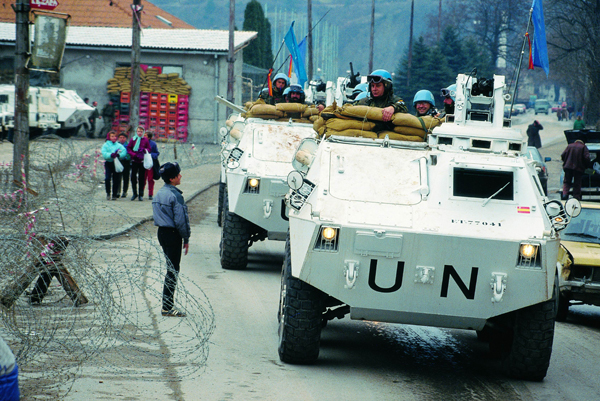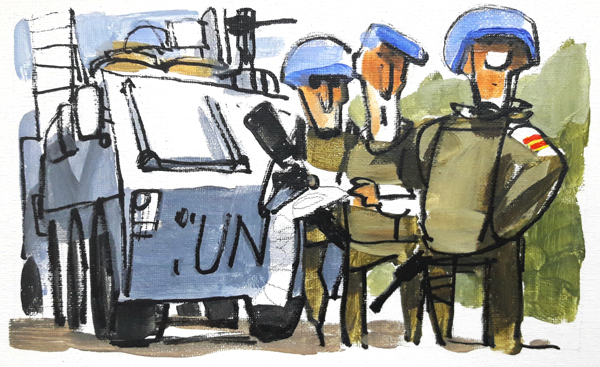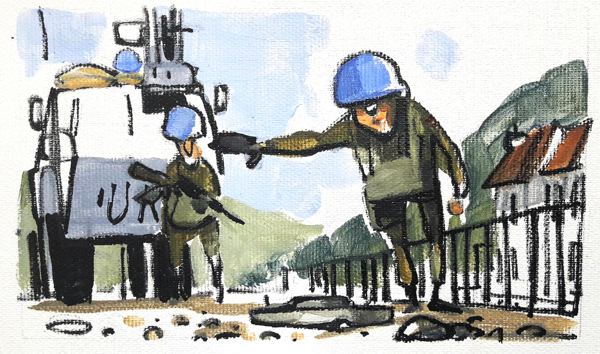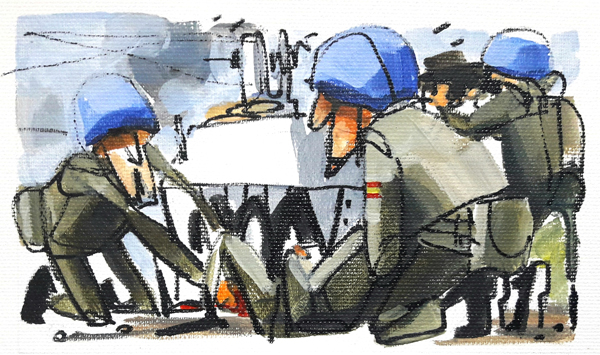A hidden mine
Captain Fernando Álvarez
12th Pontonier & Engineering Specialities Regiment
Captain José María Millán
6th Airborne Brigade Almogávares

Captain Fernando Álvarez knew where he was going. One of those places full of broken glasses, with streets and roads stratched by shrapnel, doors battered down and aways open, and lifeless windows. He asked to return to Bosnia-Herzegovina (B-H) with the Group “Madrid”. Return to do his job: deactivate explosives in a place where everything smelled like gunpowder. A place that will be remembered forever, where words got lost in the corners and valleys, and filled with war. Now is the time to fill them with memories.
On 4th December 1993 the blue helmets Spanish unit is commanded to conduct reconnaissance of the Salakovac dam and the Bijela bridge. It is the way that connects the town of Mostar with the north, Jablanica and Sarajevo, to the heart of Bosnia. At this point this is the only oxygen humanitarian aid has, a route along a winding valley that must recognised and protected. The Brijela bridge is destroyed and the Spanish blue helmets are going to conduct reconnaissance on the Salakovac dam and take it under their control. By doing so, they would have control over the river to keep the road operative, since it was flooded at that point. At both sides, the armies of the Croatian Defence Council (HVO) and of the Armija are still at war, controlling that imaginary line that is the Neretva.
The Spanish company is commanded the mission to protect and clean the area. They left the Medjugorje base this morning and one of these coincidences that mix people and circumstances, their last photograph was taken by a photograpther from Tierra newspaper.

The way is full of bends and the roads are marked by craters drawn by mortars. It is winter, and Fernando has been around the area of Bijela many times already. They were informed that two mines had been found near the bridge. The water colour emerald can be heard avoiding the dam. Captain Cifuentes’ company stays escorting the sappers near Bijela bridge. Near the press remain Captain José María Millán’s armoured vehicles, the escort of the Canadian officers and the deactivation squad. They know the dam is filled with mines.
Once they arrive at the area, Captain Fernando Álvarez, specialist in Improvised Explosive Devices, escorted by First Sergeant Jorge Fernández, goes first to conduct visual inspection and photograph the mine. Many eyes are observing in the distance, but two will pull the strings that will turn into a trap. When getting close, the Captain orders the Sergeant to move back a few metres. Bomb-disposal officers know that they must be alone when fighting invisible enemies. All the questions and answers come from the same lips, his. And he knows that, if there is someone close to danger at that point, it is him.

He approaches the artifact with caution. Meanwhile, the eyes that have prepared the trap observe him hidden in the rocks of the hillside. Those eyes would have wanted that much more people would have accompanied Fernando in his reconnaissance task, to inflict the greatest possible damage to the Spanish blue helmets, but the unit is deployed protecting the area and it is the time of the bomb-disposal officer who knows that they must be alone when fighting invisible enemies.
When he approaches the mine, which is a trap, those hidden eyes that watch them activate the explosive in the distance. A bang is heard across the valley that, as if it was a pipe, speeds up the sound towards that irreversible future that will be kept in everyone’s memory forever.
The explosion has killed Fernando
and injured the First Sergeant in one leg.
The explosion has killed Fernando and injured the First Sergeant in one leg. Fernando is lying with his leg bleeding. At that moment, shots from both lines of the front are heard. The explosion has reactivated hate, and the contenders have started to shoot at everything around them. That is why there is no time to lose, and Captain Millán, when hearing the explostion, moves close to the dam and spots Cpatain Álvarez and Sergeant First Fernández.

José María knows that seconds are crucial when a wound is not treated quickly. Shots do not stop, and supported by covering fire of the rest of the Spanish blue helmets and risking his life, he manages to take him to a safe place, where he is performed a tourniquet that cuts the severe bleeding in the leg, and is helped by the doctors who quickly respond to his partner’s call. The Paratroop Legionnaire Knights, with the driver of Captain Millán’s armoured vehicle, First Corporal Arroyo, and its shooter, John, keep providing coverage fire, with all their senses focused on the most urgent thing at this point: taking their partners out of the death zone.
In the meantime, Lieutenant Medical Balanya and Lieutenant Nurse Cabo González organise the evacuation of the injured to the Spanish advanced surgical position in Dracevo, where they manage to stabilise him and prepared him for the evacuation to Spain. After several operations at the Gómez Ulla Hospital, his leg was amputated. Jorge, who was there to protect Fernando from a possible enemy attack, knows that Fernando saved his life when he told them to wait a few metres behind, since bomb-disposal officers know that they must be alone when fighting invisible enemies, and the best way of protecting their people is putting their own lives at risk.

ARMY UNITS
- Araba Álava |
- Albacete |
- Alicante |
- Almería |
- Asturias |
- Ávila |
- Badajoz |
- Barcelona |
- Burgos |
- Cáceres |
- Cádiz |
- Cantabria |
- Castellón |
- Ceuta |
- Ciudad Real |
- Córdoba |
- A Coruña |
- Cuenca |
- Girona |
- Granada |
- Guadalajara |
- Gipuzkoa |
- Huelva |
- Huesca |
- Islas Baleares |
- Jaén |
- León |
- Lleida |
- Lugo |
- Madrid |
- Málaga |
- Melilla |
- Murcia |
- Navarra |
- Ourense |
- Palencia |
- Las Palmas |
- Pontevedra |
- La Rioja |
- Salamanca |
- Segovia |
- Sevilla |
- Soria |
- Tarragona |
- Santa Cruz de Tenerife |
- Teruel |
- Toledo |
- Valencia |
- Valladolid |
- Bizkaia |
- Zamora |
- Zaragoza



